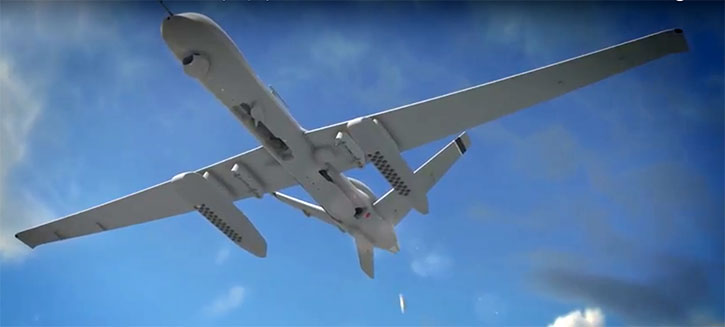
The remote detection and tracking of submerged contacts, such as submarines, was demonstrated using an MQ-9 Predator B Remotely Piloted Aircraft (RPA) during a U.S. Naval exercise on October 12th. The flight test was conducted over the Southern California Offshore Range (SCORE) west of San Clemente Island. General Atomics Aeronautical Systems, Inc. (GA-ASI) participated in this successful demonstration of new maritime patrol capabilities that included anti-submarine warfare. The test demonstrated the ability of medium altitude, long endurance drones such as the MQ-9 Reaper to detect submarines and provide persistent tracking of submerged targets.
On this demonstration, sonobuoys were deployed by U.S. Navy helicopters and acoustic data gathered from the sonobuoys were used to track underwater targets. The data was transmitted to the MQ-9 and processed onboard, then relayed to the MQ-9’s Ground Control Station (GCS) several hundred miles away from the target area.
The event successfully paired sonobuoy receiver, supplied by Ultra Electronics, and data processing technology, provided by General Dynamics Mission Systems-Canada, onboard the MQ-9. A track solution was calculated and transmitted from the aircraft to the Ground Control Station (GCS) via SATCOM. This technology will provide long-range patrol and relay capabilities to the MQ-9 to augment maritime mission sets. Ultra Electronics has also developed special pods enabling autonomous deployment of sonobuoys by the drone itself, enabling naval forces to cover larger sea areas more rapidly.
On this mission the MQ-9 also demonstrated maritime surface surveillance functions, using the Lynx Multi-mode Radar operating in the Maritime Wide-area Search (MWAS) mode, designed to detect maritime surface targets over a wide area, employing Inverse Synthetic Aperture Radar (ISAR) for surface target classification. The aircraft’s Electro-optical/Infrared (EO/IR), high-definition Full-motion Video (FMV) camera also supported the identification of surface vessels. These sensor contacts are correlated with the Automatic Identification System (AIS) to verify target identity. Additionally, the MQ-9 can be fitted with a centerline pod that can house a longer-range, 360-degree field of regard maritime surface search radar for enhanced surveillance over water.
The MQ-9 drones are employed primarily on missions over land, with a special configuration known as Guardian designed for maritime missions. The recent test employed a standard Predator B configured with avionics and sensors to meet the maritime and anti-submarine mission.




















